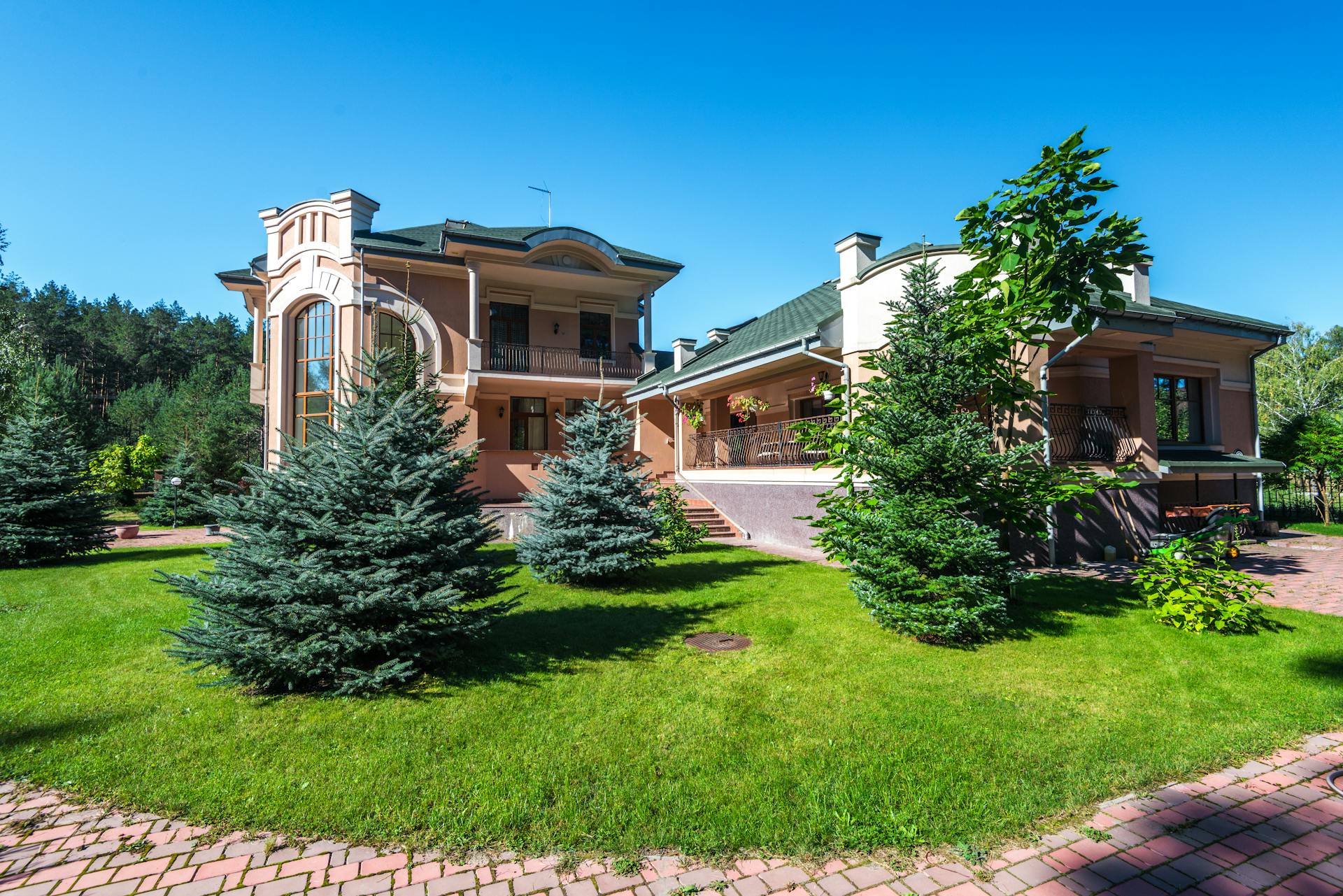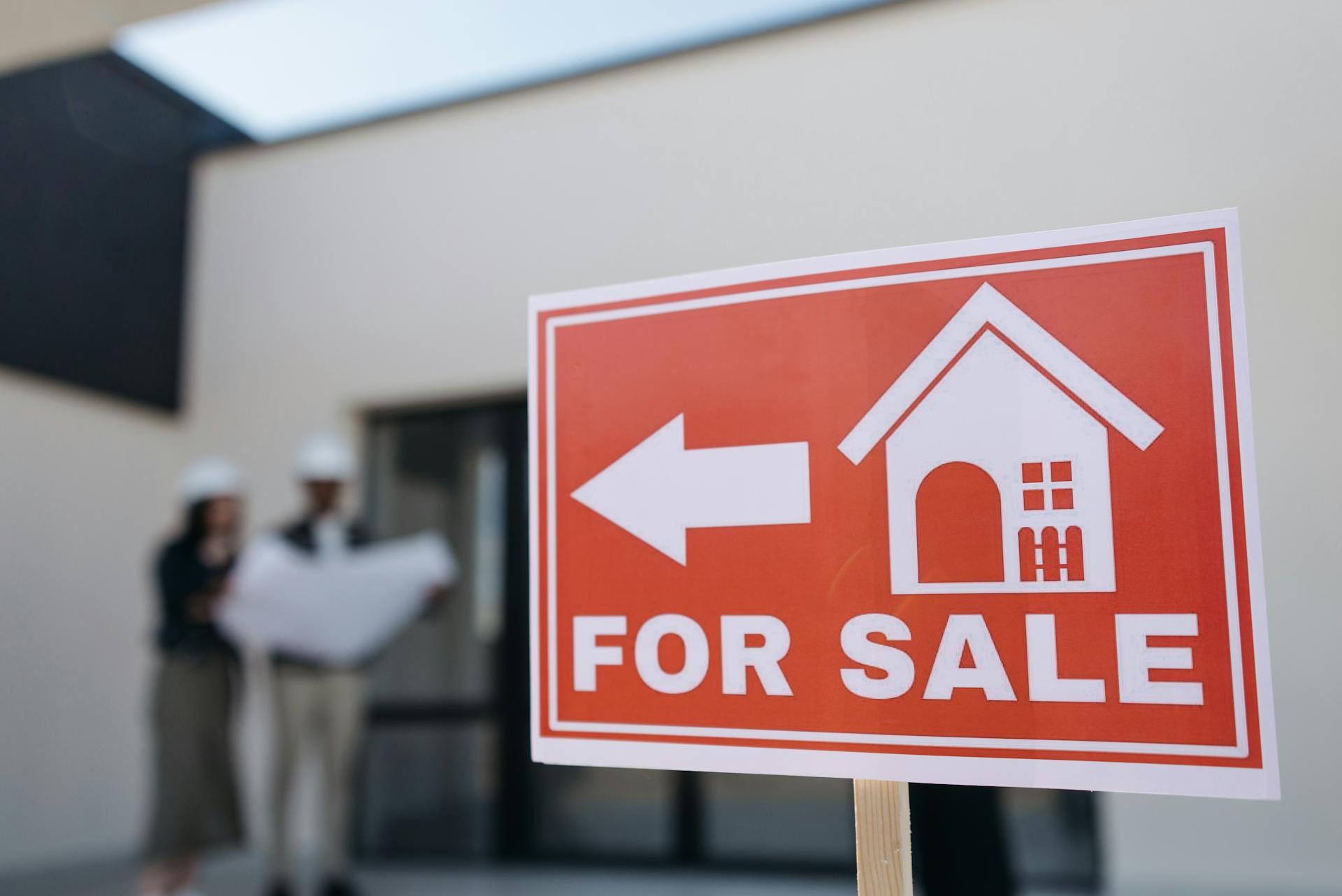
A Home Equity Line of Credit, or HELOC, is a type of loan that allows homeowners to borrow money using the equity in their home as collateral.
Home equity is the difference between the market value of your home and the amount you owe on your mortgage. For example, if your home is worth $200,000 and you owe $100,000 on your mortgage, you have $100,000 in home equity.
A HELOC allows you to tap into this equity, borrowing money as needed, up to a maximum amount set by the lender. This can be a convenient way to access cash for home improvements, debt consolidation, or other expenses.
Here's an interesting read: Commercial Real Estate Hard Money Loans
What is a Heloc?
A HELOC, or Home Equity Line of Credit, is a type of loan that lets you borrow money using your home as collateral.
It's a revolving line of credit, similar to a credit card, but it's secured by your home. This means you can borrow and repay funds as needed, without having to reapply for a new loan.
The lender approves you for a certain amount of credit, which you can access by writing a check, making a withdrawal online, or using a credit card connected to the account.
During the draw period, you may only have to pay the interest on the money you borrowed, but after the draw period ends, you enter the repayment period and must start repaying the amount due.
The lender must disclose the costs and terms of a HELOC, including the APR, payment terms, and any fees associated with the account.
Here are the six things lenders must disclose when offering a HELOC:
- APR
- Payment terms and differences during the draw period and repayment period
- Creditor's charges to open, use, or maintain the account
- Additional charges by other companies to open the line of credit
- Variable interest rate
- Brochure describing the general features of HELOCs
The lender must also give you additional information at the opening of the HELOC or before the first transaction on the account.
Benefits and Drawbacks
A Home Equity Line of Credit (HELOC) can be a great tool for homeowners, but it's essential to understand both the benefits and drawbacks before making a decision.
A HELOC is reusable, allowing you to use the credit line as needed, which can be a huge advantage for homeowners who need to make repairs or renovations.
You'll likely pay a lower interest rate with a HELOC compared to other loan options, such as personal loans or credit cards. In fact, the interest rate on a HELOC can be capped, so you won't be surprised by a sudden increase in payments.
One of the most significant benefits of a HELOC is that you're only charged interest on the amount you use, which can help keep your payments low. You can also make interest-only payments for a set time period, which can be a great option for those who want to keep their monthly payments low.
Tax benefits are another advantage of a HELOC. If you use the funds for home improvements, you may be able to write off the interest at tax time.
However, there are some potential drawbacks to consider. For example, a HELOC can increase the risk of foreclosure if you're unable to pay the loan. It's also not recommended if your income is unstable or if you won't be able to afford payments if interest rates rise.
See what others are reading: Can You Increase a Heloc
Here are some key points to keep in mind:
Getting a Heloc
Whether a home equity line of credit is a good idea really comes down to your goals and financial situation.
It's essential to consider your financial stability before applying for a HELOC, as it can be a significant burden if not managed properly.
Ultimately, getting a HELOC can be a good idea if you have a stable income and can afford the monthly payments, but it's crucial to assess your financial situation first.
Readers also liked: Financial Partners Heloc
How to Get
To get a HELOC, you'll need to have a good credit score, as lenders typically require a minimum score of 620. This is because HELOCs are considered a secured loan, backed by the equity in your home.
You'll also need to have sufficient equity in your home, with most lenders requiring at least 20% equity. This means that if your home is worth $100,000, you'll need to have at least $20,000 in equity.
On a similar theme: What Credit Score Do You Need for Heloc
The interest rate on a HELOC is usually variable, meaning it can change over time. This is because HELOCs are tied to the prime lending rate, which can fluctuate.
To qualify for a HELOC, you'll need to have a steady income and a good debt-to-income ratio. This is because lenders want to ensure you can afford the monthly payments.
Most HELOCs have a draw period of 5-10 years, during which you can borrow money as needed. After the draw period ends, you'll enter a repayment period, where you'll need to pay back the borrowed amount plus interest.
You can use a HELOC for various purposes, such as paying off high-interest debt, financing home improvements, or covering unexpected expenses.
Curious to learn more? Check out: Heloc Seven Year Draw Terms and Conditions
Getting a Good Idea?
Whether a home equity line of credit is a good idea really comes down to your goals and financial situation. Your financial situation is crucial, as it will determine how much you can borrow and whether you can afford the repayments.
Your goals play a significant role in deciding whether a HELOC is a good idea. If you need to borrow a large sum of money, a HELOC might be a viable option.
If this caught your attention, see: Is a Heloc Worth It
Heloc vs Other Options
A HELOC can be a good option if you want to leave your original mortgage untouched, but be prepared for a higher interest rate and possibly a variable rate. This could be a better choice if you have ongoing expenses that you need to cover regularly.
If you're looking to tap into your home equity, you have a few options to consider. A home equity loan, for example, will give you a lump sum upfront and fixed monthly payments, which can be a good fit if you need a large sum of cash upfront. On the other hand, a personal loan doesn't require you to tie the debt to your home, which can be a more comfortable option if you're not sure about committing to a home-based loan.
In terms of interest rates, a HELOC might be the way to go if you want to pay as little interest as possible. However, if you're not comfortable tying new debt to your home, a personal loan could be a better choice.
Broaden your view: What Does You're a Real One Mean?
Differences from Conventional Loans
A HELOC is different from a conventional loan in that the borrower isn't advanced the entire sum up front, but uses a line of credit to borrow sums that total no more than the credit limit, similar to a credit card.
The term of a HELOC is split into two distinct periods: the "draw period" and the "repayment period". The draw period typically lasts 10 years.
During the draw period, the borrower can use their HELOC like a revolving facility, drawing down funds, repaying, and redrawing again as many times as they wish, only paying interest on their outstanding balance.
The repayment period is when the outstanding balance plus interest is due, either as a lump-sum balloon payment or according to a loan amortization schedule.
Early repayment can usually be made at any time in the term and can range from the minimum payment to the full drawn amount plus interest.
Lenders determine the amount they can lend to a borrower based on two variables: the value of the security property and the borrower's creditworthiness, expressed in a combined loan-to-value (CLTV) ratio.
For more insights, see: Heloc Maximum
vs. Cash-out Refinance
A cash-out refinance is a popular option for tapping home equity, but how does it compare to a HELOC? A cash-out refinance replaces your current mortgage with a larger loan, allowing you to "cash out" the difference between the two amounts.
The maximum LTV ratio for most cash-out refinance programs is 80%, but the VA cash-out refinance program is an exception, allowing military borrowers to tap up to 90% of their home's value with a loan backed by the U.S. Department of Veterans Affairs (VA).
One key difference between a cash-out refinance and a HELOC is the way you access funds. With a cash-out refinance, you receive a lump sum upfront, whereas with a HELOC, you can drawdown funds as needed, similar to a credit card.
Interest rates are currently high, making it unlikely that you'll get a rate lower than the one attached to your original mortgage with a cash-out refinance. This might make a HELOC a more attractive option if you want to leave your original mortgage untouched.
Worth a look: Va Cash Out Refi Ltv
Alternatives to a: Which is Better?
A home equity loan is good when you need a large sum of cash upfront and you like fixed monthly payments.
If you don't make a lot of money or don't have sufficient savings, a fixed rate mortgage can help ensure payments are made on time regularly.
A HELOC may work better if you have ongoing expenses, but the roaming rate can cause a spike in your monthly budget, even with minimum interest payments.
Speaking with your Edmonton Real Estate Lawyer can help outline the benefits and disadvantages of each option for your specific financial situation.
Take a look at this: Are Heloc Rates Fixed or Variable
Heloc Rates and Lenders
Shopping around is key when looking for the best HELOC rate. Check your bank or mortgage provider, as it might offer discounts to existing customers.
To get the best HELOC rate, shop around with at least three lenders. Take note of introductory offers like initial rates that will expire at the end of a given term.
Recommended read: Best Way to Use a Heloc
Here are some top HELOC lenders to consider:
Improving your credit score and reducing the amount of home equity you borrow can also help you find the best HELOC rates and lenders.
How Much Can I Borrow?
Your home's value is a key factor in determining how much you can borrow with a HELOC. The lender will allow you to access up to 85% of your home's value, so if your home is worth $300,000, the maximum amount of equity that could be borrowed is $255,000.
To calculate the total amount you can borrow, subtract the remaining balance on your mortgage from the maximum amount of equity that could be borrowed. For example, if you owe $200,000 on your mortgage, the total amount you can borrow with a HELOC is $55,000.
Your LTV ratio, or loan-to-value ratio, is also important in determining how much you can borrow. This ratio is normally capped at 85%, which means that the combined total of your current mortgage and the new HELOC amount can't exceed 85% of your home's appraised value.
Check this out: How Do I Know If My Loan Is a Heloc
Finding Best Rates and Lenders
Finding the best HELOC rates and lenders requires some research and planning. Your credit score plays a significant role in determining the interest rate you'll qualify for, with most HELOC rates indexed to the prime rate.
Most lenders will offer you a rate based on your credit score, existing debt, and the amount you wish to borrow. You can expect to pay a higher rate if you have poor credit or a large amount of debt. A lender may add a margin to the prime rate to calculate your rate offer, for example, a 1.5% margin added to a prime rate of 8.5% results in a rate of 10%.
To find the best HELOC rates, shop around with at least three lenders and compare their offers. You can also check with your bank or mortgage provider, as they may offer discounts to existing customers. Some lenders offer introductory rates that will expire at the end of a given term, so be sure to read the fine print.
If this caught your attention, see: When Will Chase Offer Heloc Again
You can get at least three to five quotes from HELOC lenders to compare costs. Improving your credit score can also help you qualify for better rates. Reducing the amount of home equity you borrow can also lead to lower rates.
Our top picks for HELOC lenders include lenders that offer a range of loan terms, including 10-year draw periods and 20-year repayment periods. Some lenders also offer fixed-rate options, which can protect your loan from rising interest rates. Here are some key features to look for in a HELOC lender:
- Variable interest rates that adjust based on the prime rate
- Fixed-rate options to lock in your APR
- Loan terms that include a draw period and a repayment period
- Low or no closing costs
- Fast closing options
Remember to check your lender's LTV ratio, which is the percentage of your home's value that you can borrow against. Most lenders cap the LTV ratio at 85%, but some may offer higher or lower limits.
Additional reading: 95 Ltv Heloc
Heloc Process and Costs
A HELOC can come with some additional costs beyond just interest. Closing costs, which are typically between 2% and 5% of the loan amount, are one of them.
For more insights, see: Equity Loan Closing Costs
Some lenders don't charge closing costs at all, but be aware that this can be contingent on keeping the line open for a certain amount of time. Annual fees are another cost to consider, which can be around $50 per year.
These costs can add up, so it's essential to factor them into your decision-making process.
A fresh viewpoint: Does Heloc Have Closing Costs
How it Works
A HELOC, or home equity line of credit, gives you the flexibility to borrow against your home equity, repay and repeat. Because HELOCs are secured by an asset – your home – interest rates are typically competitive, but also make them riskier, as you can lose your home if you can't make payments.
The draw period, usually lasting 10 years, is when you can borrow money from the account, up to your approved limit. During this time, you have to make interest payments, but payments towards the principal are optional.
Here's a breakdown of the two phases of a HELOC:
The repayment period, which can last up to 20 years, is when you can't take out more money and have to make both principal and interest payments until you've paid off what you've borrowed. This is where your monthly payments can rise sharply compared to the draw period.
Expand your knowledge: 3 Day Rescission Period Heloc
Cost Estimate
When considering a HELOC, it's essential to factor in the costs beyond just the interest. Closing costs can range from 2% to 5% of the loan amount, and some lenders may not charge them at all, but this can come with conditions.
These costs can add up quickly, so it's crucial to understand what you're getting into. Some lenders may charge annual fees, typically around $50 per year.
To give you a better idea of what to expect, here's a breakdown of the costs you might face:
Keep in mind that some lenders may not charge closing costs, but this can come with conditions.
Monthly Payment on $100,000
The monthly payment on a $100,000 HELOC can vary depending on how much of the credit line you've used.
Assuming you've spent up to your credit limit, the monthly payment would be around $649 for an interest-only payment, or $823 for a principal-and-interest payment.
Related reading: No down Payment Commercial Loans
You only have to make payments on the money you've used, making your payments potentially lower if you haven't tapped into the full amount of the line of credit.
Your lender may offer different payment options, but it's essential to understand your payment terms and interest rate to make informed decisions about your HELOC.
Explore further: Using Heloc as down Payment
Frequently Asked Questions
What is the monthly payment on a $50,000 HELOC?
For a $50,000 HELOC, monthly payments are approximately $384 for interest-only or $457 for principle-and-interest, depending on the payment type. Review your options to determine the best payment plan for your needs.
What is the downside of a HELOC?
A HELOC can come with significant risks, including the possibility of losing your home if you're unable to pay back the loan. Additionally, the initial draw period can create a false sense of financial security, leading to a harsh reality check when repayment begins.
Sources
- https://www.nerdwallet.com/article/mortgages/heloc-home-equity-line-of-credit
- https://en.wikipedia.org/wiki/Home_equity_line_of_credit
- https://consumer.ftc.gov/articles/home-equity-loans-and-home-equity-lines-credit
- https://www.edmontonlaw.ca/edmonton-real-estate-lawyer/conventional-mortgage-vs-heloc/
- https://www.lendingtree.com/home/home-equity/heloc/what-is-a-home-equity-line-credit/
Featured Images: pexels.com


